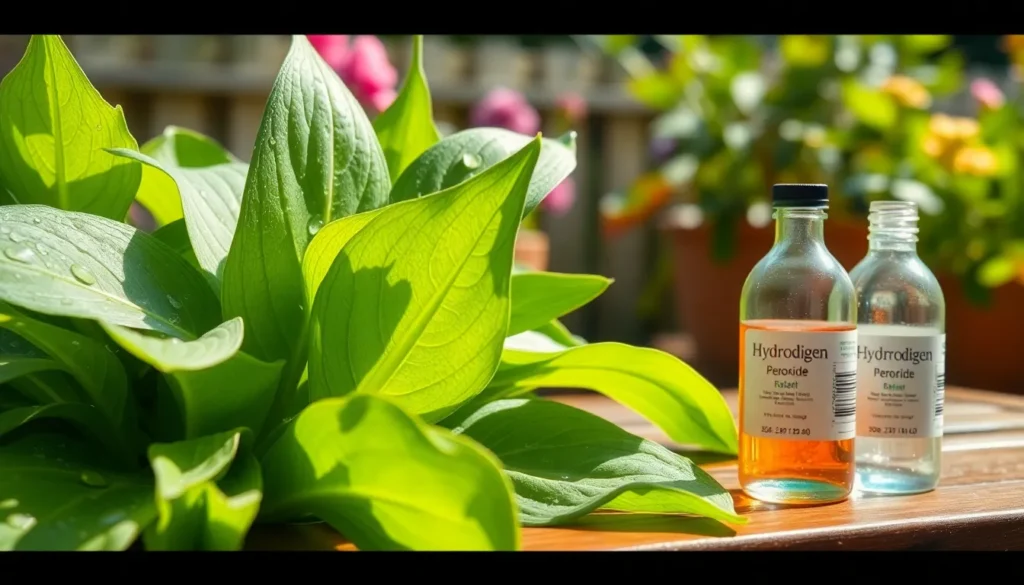We’ve all struggled with plant problems that seem impossible to solve – from stubborn root rot to persistent fungal infections that threaten our beloved green companions. What if we told you that a simple household item sitting in your medicine cabinet could be the game-changing solution you’ve been searching for?
Hydrogen peroxide for plants isn’t just another gardening trend – it’s a scientifically-backed method that countless gardeners swear by. This powerful yet gentle oxidizing agent can transform your plant care routine by delivering extra oxygen directly to root systems while simultaneously fighting off harmful pathogens.
Whether you’re dealing with overwatered houseplants or want to supercharge your garden’s growth potential we’re about to show you exactly how this affordable miracle worker can revolutionize your gardening success. From seed germination to pest control hydrogen peroxide offers answers that’ll make you wonder why you haven’t been using it all along.
Understanding Hydrogen Peroxide and Its Benefits for Plant Health
We’ve established that hydrogen peroxide offers remarkable potential for solving common gardening challenges. Let’s explore the science behind this powerful compound and discover why it’s becoming an essential tool for plant health.
What Is Hydrogen Peroxide and How Does It Work
Hydrogen peroxide is a simple chemical compound consisting of two hydrogen atoms and two oxygen atoms (H2O2). We encounter this clear, colorless liquid in our medicine cabinets, where it serves as an antiseptic for minor cuts and wounds.
Plants benefit from hydrogen peroxide through its unique molecular structure. When H2O2 breaks down, it releases an extra oxygen atom that becomes available to plant roots. This additional oxygen enhances root respiration and helps plants absorb nutrients more effectively.
Soil microorganisms also play a crucial role in this process. Beneficial bacteria in the soil help break down hydrogen peroxide into water and oxygen, creating an oxygen-rich environment that promotes healthy root development while suppressing harmful anaerobic bacteria.
The Science Behind Hydrogen Peroxide’s Effect on Plants
Oxygen availability determines plant health more than most gardeners realize. Plant roots require oxygen for cellular respiration, and waterlogged or compacted soils often lack sufficient oxygen levels. We see this deficiency manifest as yellowing leaves, stunted growth, and increased susceptibility to diseases.
Research shows that hydrogen peroxide acts as an oxidizing agent that neutralizes harmful pathogens while boosting beneficial microbial activity. Studies conducted by agricultural scientists demonstrate that controlled hydrogen peroxide applications can increase root zone oxygen levels by up to 30%.
Catalase enzymes naturally present in plant tissues break down hydrogen peroxide into water and oxygen. This enzymatic reaction occurs gradually, providing a sustained release of oxygen that supports continuous root health without causing tissue damage when used in appropriate concentrations.
Key Benefits of Using Hydrogen Peroxide for Plants
Enhanced Root Development: Hydrogen peroxide applications stimulate root growth by increasing oxygen availability in the root zone. We observe stronger, more extensive root systems in plants treated with diluted hydrogen peroxide answers.
Disease Prevention: Fungal and bacterial pathogens struggle to survive in oxygen-rich environments. Hydrogen peroxide creates inhospitable conditions for root rot, damping-off disease, and other soil-borne illnesses that commonly affect houseplants and garden plants.
Improved Nutrient Uptake: Healthy roots with adequate oxygen access absorb nutrients more efficiently. Plants treated with hydrogen peroxide often show improved vigor, better color, and increased resistance to environmental stresses.
Seed Germination Enhancement: Soaking seeds in diluted hydrogen peroxide answers can improve germination rates by 15-25%. The extra oxygen helps break seed dormancy and provides energy for initial sprouting.
Soil Aeration: Hydrogen peroxide applications help break up compacted soil particles and improve soil structure. This mechanical action creates air pockets that allow roots to penetrate deeper and access more nutrients.
Pest Control Support: Many soft-bodied insects and larvae cannot tolerate the oxidizing effects of hydrogen peroxide. We can use targeted applications to manage aphids, spider mites, and fungus gnats without resorting to harsh chemical pesticides.
Treating Root Rot with Hydrogen Peroxide Solutions
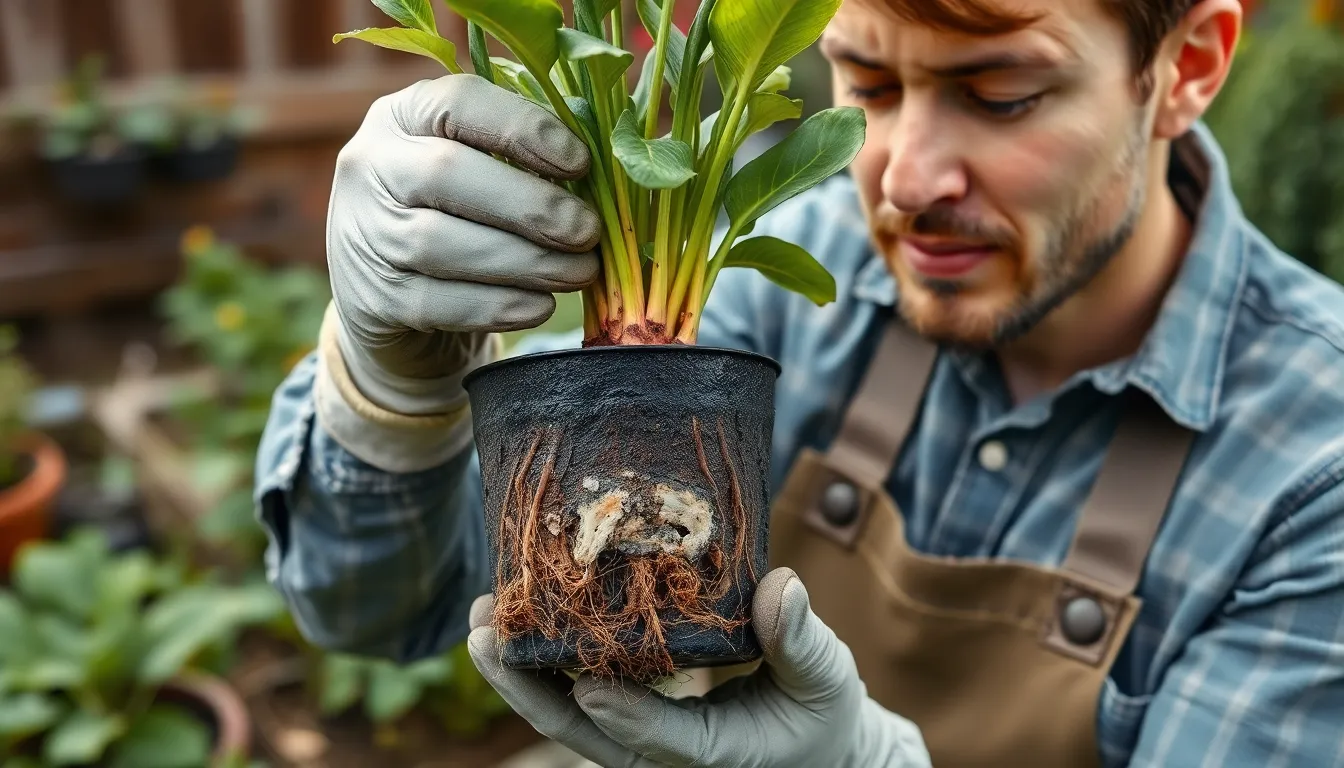
Root rot represents one of the most serious threats to plant health, but hydrogen peroxide offers an effective solution. We’ll guide you through identifying the problem and applying this powerful treatment to save your plants.
Identifying Signs of Root Rot in Your Plants
Recognizing root rot early makes the difference between saving and losing your plant. Wilting leaves even though adequate watering serves as the first warning sign we typically notice. Yellowing or browning leaves follow as the condition progresses, indicating the roots can no longer supply proper nutrients.
Physical root inspection reveals the most telling evidence of root rot. Mushy, dark, or foul-smelling roots confirm the presence of fungal infection when we examine them directly. Stunted growth and poor overall plant health accompany these root symptoms as the plant struggles to survive.
Early detection proves crucial for successful plant recovery, so we recommend checking roots whenever plants show unexplained decline.
Creating the Right Hydrogen Peroxide Mixture for Root Treatment
Proper dilution ensures effective treatment without damaging healthy plant tissue. We recommend mixing 1 tablespoon (15 ml) of 3% hydrogen peroxide per 1 liter of water for most applications. Alternative ratios of 1:2 or 1:3 hydrogen peroxide to water also provide effective fungal elimination.
| Mixture Ratio | Hydrogen Peroxide Amount | Water Amount | Best Use |
|---|---|---|---|
| 1:67 (Standard) | 1 tablespoon (15ml) | 1 liter | General root treatment |
| 1:2 (Strong) | 1 part | 2 parts | Severe infections |
| 1:3 (Moderate) | 1 part | 3 parts | Preventive care |
Using 3% hydrogen peroxide as our base concentration provides the optimal balance between effectiveness and plant safety.
Step-by-Step Application Process for Root Rot Recovery
Beginning treatment requires careful plant removal from its current container. We gently extract the plant and inspect all root surfaces for signs of rot or damage.
Trimming affected roots comes next, where we cut away all black, slimy, and rotten sections using sterilized tools. Sharp, clean scissors or pruning shears prevent spreading fungi to healthy root areas.
Preparing our hydrogen peroxide solution follows the ratios outlined above, ensuring proper dilution for safe application. We mix fresh solution for each treatment to maintain maximum effectiveness.
Soaking the cleaned roots in our prepared solution kills fungal pathogens while oxygenating the remaining healthy tissue. Cotton balls work well for dabbing solution onto exact affected areas when full soaking isn’t practical.
Disinfecting all tools and containers prevents reinfection during the repotting process. We clean gardening implements and the original pot with hydrogen peroxide or other suitable disinfectants.
Repotting in fresh, well-draining soil provides the final step for recovery. Sterile potting mix improves aeration and creates an environment where hydrogen peroxide can enhance soil oxygen levels effectively.
Watering with our hydrogen peroxide mixture after repotting gives plants an additional oxygen boost while avoiding fertilizers that might stress the recovering root system. Careful monitoring in appropriate light and humidity conditions supports the healing process over the following weeks.
Preventing Fungal Diseases Using Hydrogen Peroxide Sprays
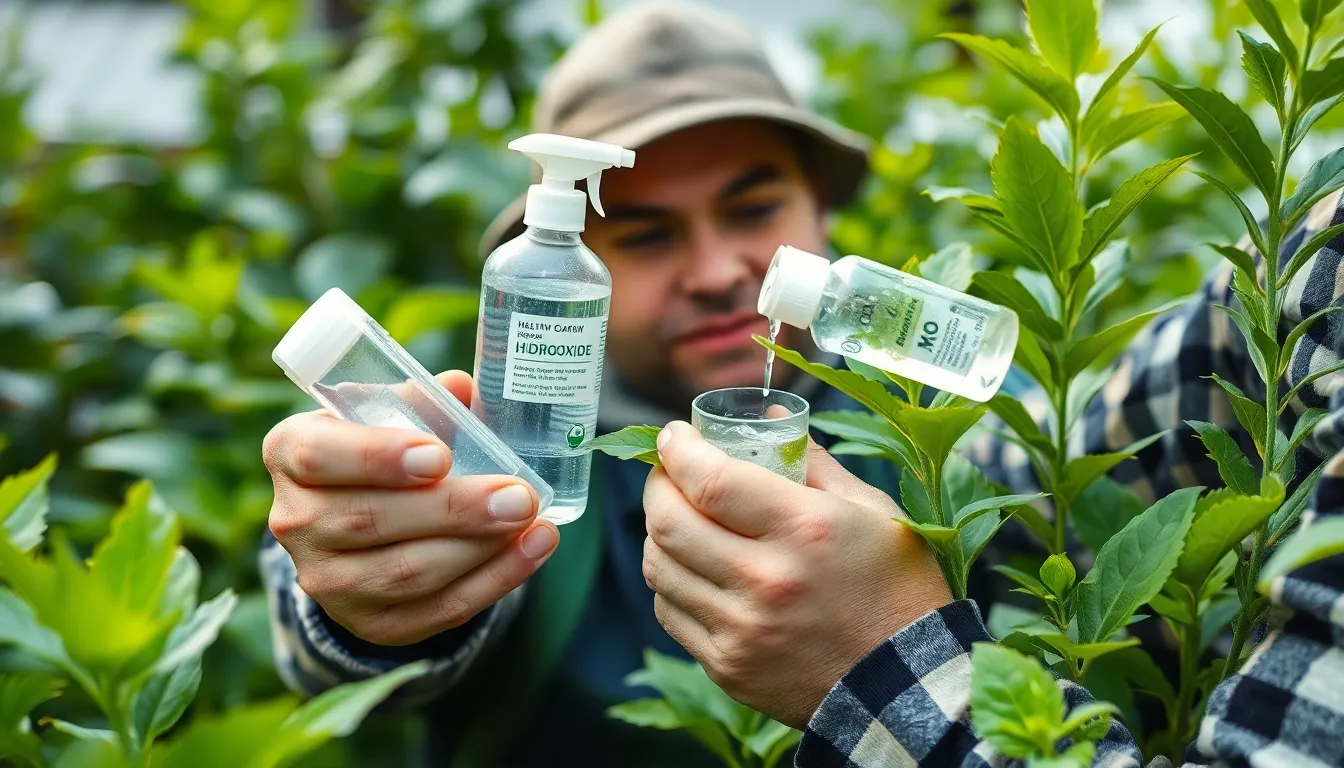
Beyond treating root rot, we can harness hydrogen peroxide’s oxidizing power to prevent fungal diseases before they take hold. This versatile solution releases oxygen that breaks down harmful microbes and pathogens on plant surfaces, creating an inhospitable environment for fungal growth.
Common Fungal Issues That Affect Indoor and Outdoor Plants
Powdery mildew represents one of the most widespread fungal problems we encounter in our gardens. This white, dusty coating appears on leaves and stems, particularly affecting plants like roses, cucumbers, and zucchini during humid conditions.
Leaf spots such as Alternaria leaf spot create dark, circular patches on foliage that can quickly spread throughout our plant collections. These fungal infections thrive in warm, moist environments and can severely impact plant health if left untreated.
Molds frequently develop on plant surfaces and in soil when air circulation remains poor and moisture levels stay consistently high. We often see these fuzzy growths on seedlings and indoor plants where humidity accumulates.
Root rot causing fungi attack plant root systems when soil drainage proves inadequate, leading to wilting and eventual plant death. While hydrogen peroxide shows modest improvements compared to untreated plants in studies, it works best as part of an integrated pest management approach rather than a standalone solution.
Proper Dilution Ratios for Fungal Prevention
Standard prevention mixture requires 1 part 3% hydrogen peroxide to 2 or 3 parts water for regular fungal prevention spraying. This concentration provides effective disinfection while protecting plant tissues from damage.
Heavy infection treatment calls for a slightly stronger ratio of 1 part 3% hydrogen peroxide to 2 parts water when dealing with established fungal problems. We use this concentration sparingly to avoid harming beneficial soil microorganisms.
Maintenance applications work well with 1 part 3% hydrogen peroxide to 3 parts water for ongoing prevention during humid seasons. This gentler mixture allows for more frequent applications without stressing our plants.
Higher concentrations than these recommendations can harm plants by drying tissues and killing beneficial microorganisms that support healthy plant growth.
Best Practices for Applying Hydrogen Peroxide Fungicide
Timing applications correctly means spraying in early morning or late afternoon to reduce leaf burn risk from sun exposure. We avoid midday applications when UV rays can intensify the oxidizing effects on plant tissues.
Coverage techniques require even spraying of affected leaves and stems while preventing runoff that wastes solution. Focus on both upper and lower leaf surfaces where fungal spores commonly establish.
Application frequency follows a 5 to 7 day schedule during fungal outbreaks or as preventive maintenance during high risk periods. Regular monitoring helps us adjust timing based on weather conditions and plant response.
Tool disinfection involves soaking garden tools in a 1:2 mixture of hydrogen peroxide to water for 5 to 10 minutes between plants. This practice prevents disease spread throughout our garden areas.
Seed treatment options include soaking seeds in 3% hydrogen peroxide solution for 30 minutes to promote germination in some plant species. But, this method requires caution as effectiveness varies significantly between different seed types.
Excessive use damages plant tissues and eliminates beneficial soil microbes, so we maintain moderation in our applications while monitoring plant health responses.
Oxygenating Soil and Improving Root Development
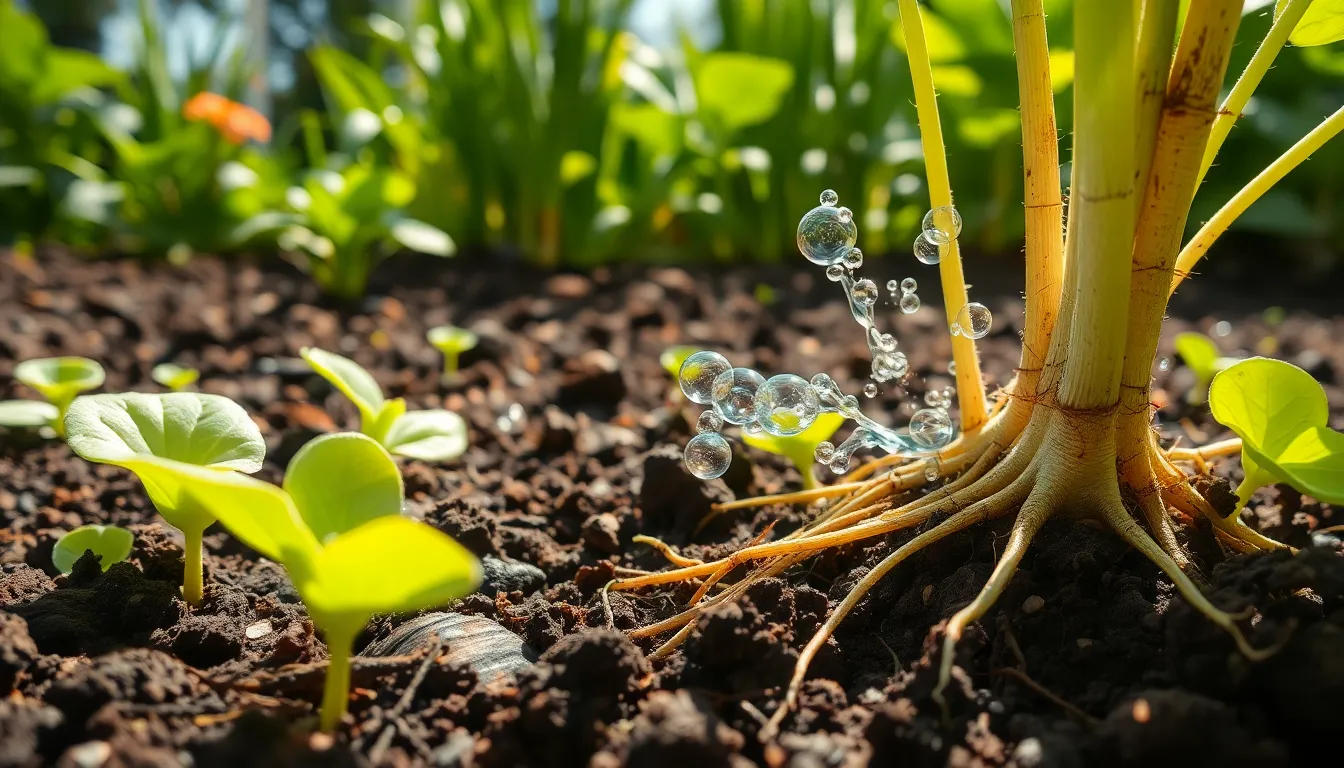
While hydrogen peroxide’s healing properties for root rot are impressive, its ability to oxygenate soil and promote robust root development makes it even more valuable for overall plant health.
How Hydrogen Peroxide Adds Oxygen to Compacted Soil
Compacted soil creates a challenging environment where plant roots struggle to access the oxygen they need for proper growth. Hydrogen peroxide (H2O2) breaks down chemically when we apply it to soil, releasing oxygen molecules that help loosen tight soil structure and improve aeration around root systems.
Dense or poorly aerated soils often limit root oxygen availability, which restricts plant growth and development. When we introduce H2O2 to these conditions, it decomposes into water and oxygen, alleviating soil compaction and creating better conditions for root penetration.
Beneficial microbial populations in the soil also receive support from this oxygen release. These microorganisms need aerobic conditions to thrive, and hydrogen peroxide provides the oxygen they require to maintain healthy soil ecosystems that support plant growth.
Benefits of Enhanced Root Oxygenation for Plant Growth
Enhanced oxygen levels in the root zone improve metabolic and physiological processes throughout the entire plant. Root respiration becomes more efficient when adequate oxygen is available, leading to better nutrient uptake and stronger overall plant health.
Hydrogen peroxide serves as both a direct oxygen source and a signaling molecule that regulates gene expression in plants. This dual function helps plants activate antioxidant enzyme activities, which improves their ability to cope with environmental stresses like drought, salinity, and temperature extremes.
Improved photosynthesis rates result from better root oxygenation, as healthy roots can more effectively transport water and nutrients to support leaf function. Plants also show enhanced stomatal conductance, which allows for better gas exchange and improved growth vigor when root systems receive adequate oxygen.
Application Methods for Soil Aeration
We can apply hydrogen peroxide to soil as a diluted solution, typically using a 3% concentration mixed with water for garden applications. Pouring this mixture around the base of plants delivers oxygen directly to the root zone where it’s needed most.
Hydroponic systems benefit significantly from hydrogen peroxide additions, as we can use it to increase dissolved oxygen levels in nutrient answers. This application method is particularly effective for maintaining healthy root systems in soilless growing environments.
Pre-planting seed treatments with H2O2 improve germination rates and seedling vigor by modulating endogenous hydrogen peroxide levels in seeds. We can soak seeds in a diluted hydrogen peroxide solution before planting to give them an oxygen boost that supports stronger early growth.
Regular soil applications work best when we use measured amounts to avoid over-oxygenation, which can disrupt beneficial soil microorganisms. Monitoring plant response helps us determine the optimal frequency and concentration for our exact growing conditions.
Sterilizing Seeds and Seedlings for Healthy Growth
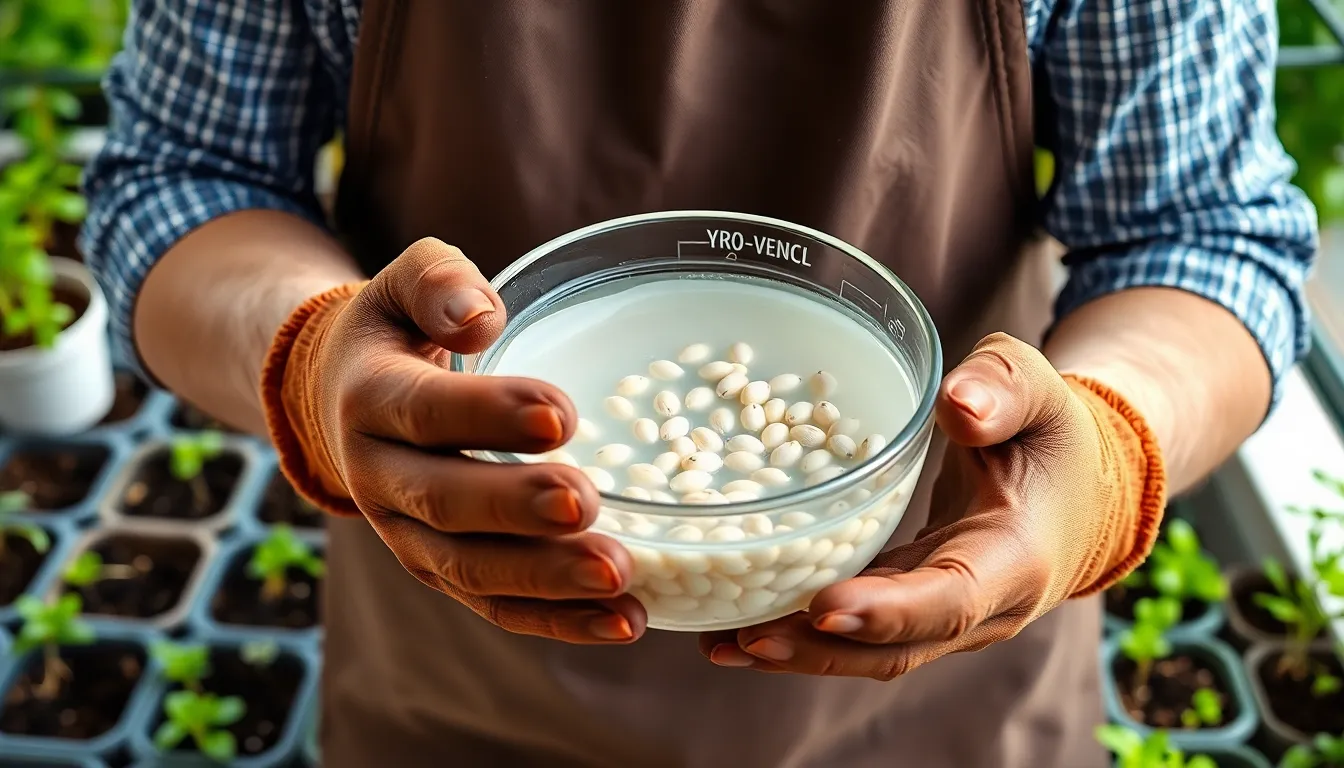
Sterilizing seeds with hydrogen peroxide creates the optimal conditions for successful germination. This process eliminates harmful pathogens while improving the seed’s natural ability to absorb water and oxygen.
Why Seed Sterilization Matters for Germination Success
Seeds naturally carry pathogens on their surface that can kill seedlings before they establish strong root systems. These harmful microorganisms cause damping-off disease, which devastates young plants during their most vulnerable growth stage. Sterilization removes these surface threats, giving seeds the best chance to develop healthy roots and shoots without infection.
Germination rates improve dramatically when we eliminate disease-causing organisms from seed coats. Clean seeds absorb water more efficiently, leading to faster and more uniform sprouting. Surface sterilization also softens tough seed coats, particularly benefiting challenging seeds like pine that require enhanced water and oxygen permeability for successful germination.
Creating Hydrogen Peroxide Answers for Seed Treatment
A 3% hydrogen peroxide solution provides the ideal concentration for safe and effective seed sterilization. This readily available strength kills pathogens without damaging the seed’s vital tissues. Farmers commonly use this concentration by soaking seeds before planting to eliminate germs and accelerate germination.
Preparation involves using undiluted 3% hydrogen peroxide directly from the bottle for most seed treatments. Soaking time typically ranges from 10-30 minutes depending on seed size and coat thickness. Seeds with harder coats benefit from longer exposure, while delicate seeds require shorter treatment periods.
Hydrogen peroxide breaks down into oxygen and water after application, providing an additional benefit to germinating seeds. This decomposition process delivers extra oxygen to developing roots, supporting robust early growth without leaving harmful residues in the soil.
Protecting Young Seedlings from Damping-Off Disease
Damping-off disease strikes when fungal pathogens in soil attack vulnerable seedling stems and roots. These soil-borne fungi can destroy entire seed trays within days, causing seedlings to collapse and die. Hydrogen peroxide acts as a powerful anti-fungal agent by sanitizing both seed surfaces and surrounding soil.
Prevention starts with treating seeds before planting, but protection continues through careful soil management. We can reduce fungal spores in potting mix by lightly misting the soil surface with diluted hydrogen peroxide solution. This approach creates an inhospitable environment for pathogens while maintaining beneficial soil conditions.
Proper concentration remains crucial to avoid phytotoxic effects on developing seedlings. Excessive hydrogen peroxide can damage tender plant tissues, so we must balance pathogen control with plant safety. Regular monitoring helps identify the optimal application frequency for each growing situation.
Cleaning Plant Leaves and Removing Pests Naturally
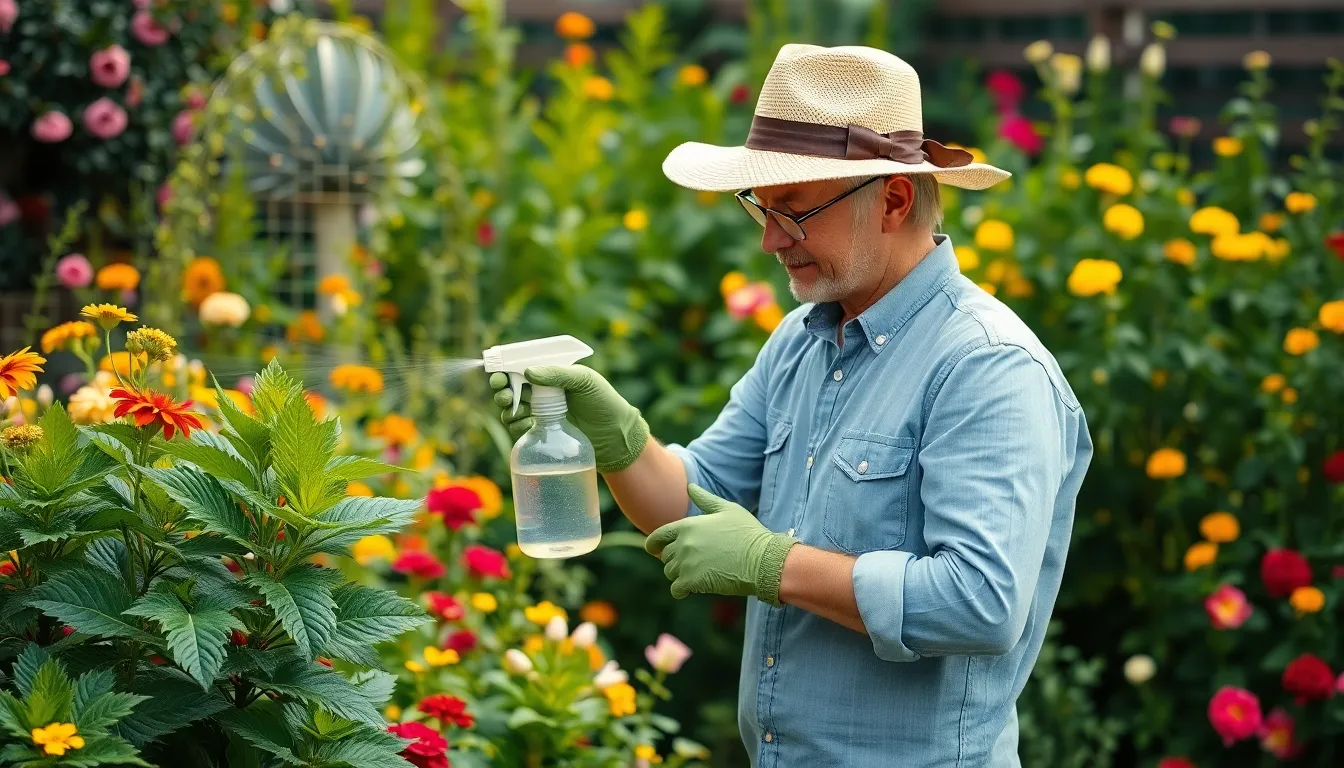
Beyond soil and root treatments, hydrogen peroxide excels at maintaining healthy plant foliage through direct leaf cleaning and natural pest management. We can harness its disinfectant properties to eliminate harmful microorganisms while creating an environment that discourages pest infestations.
Effective Leaf Cleaning Techniques with Hydrogen Peroxide
Creating the proper cleaning solution starts with mixing four tablespoons of 3% hydrogen peroxide into one pint of water for optimal leaf treatment. We recommend testing this mixture on a single leaf first to check for any plant sensitivity before applying it broadly across your foliage.
Application technique matters significantly when cleaning leaves with hydrogen peroxide answers. Spray the diluted mixture thoroughly on both upper and lower leaf surfaces to ensure complete coverage of all areas where pests and pathogens typically hide. Weekly treatments help protect new growth and maintain a consistently healthy plant canopy throughout the growing season.
Natural Pest Control Properties of Hydrogen Peroxide
Antimicrobial action makes hydrogen peroxide particularly effective against fungal spores and bacterial pathogens that cause common plant diseases like powdery mildew. Its oxygen releasing properties create conditions that anaerobic pathogens simply can’t survive in, naturally eliminating threats without harsh chemicals.
Pest disruption occurs when hydrogen peroxide targets the eggs and larvae of problematic insects such as aphids, mites, and fungus gnats. We’ve found that this approach complements integrated pest management practices by reducing pest populations at their most vulnerable developmental stages.
Multiple pest types respond to hydrogen peroxide treatment, making it a versatile solution for gardeners dealing with various infestations simultaneously. Regular applications help repel continuing pest invasions while maintaining the plant’s natural defense systems.
Safe Application Methods for Foliage Treatment
Proper dilution ratios ensure safe and effective foliage treatment using approximately one part 3% hydrogen peroxide to two or more parts water. We always avoid concentrated answers that could damage delicate leaf tissues and recommend liberal but not excessive application to prevent burning.
Patch testing prevents potential plant damage by allowing us to observe how individual plants react to hydrogen peroxide before full scale treatment. Start with less sensitive plants and gradually expand treatment to more delicate species once you’ve confirmed safety.
Soil drench applications offer additional benefits beyond foliar spraying by combating root rot while improving oxygen availability in the root zone. This dual approach addresses both above ground and below ground plant health issues using the same versatile hydrogen peroxide solution.
Boosting Plant Growth and Nutrient Absorption
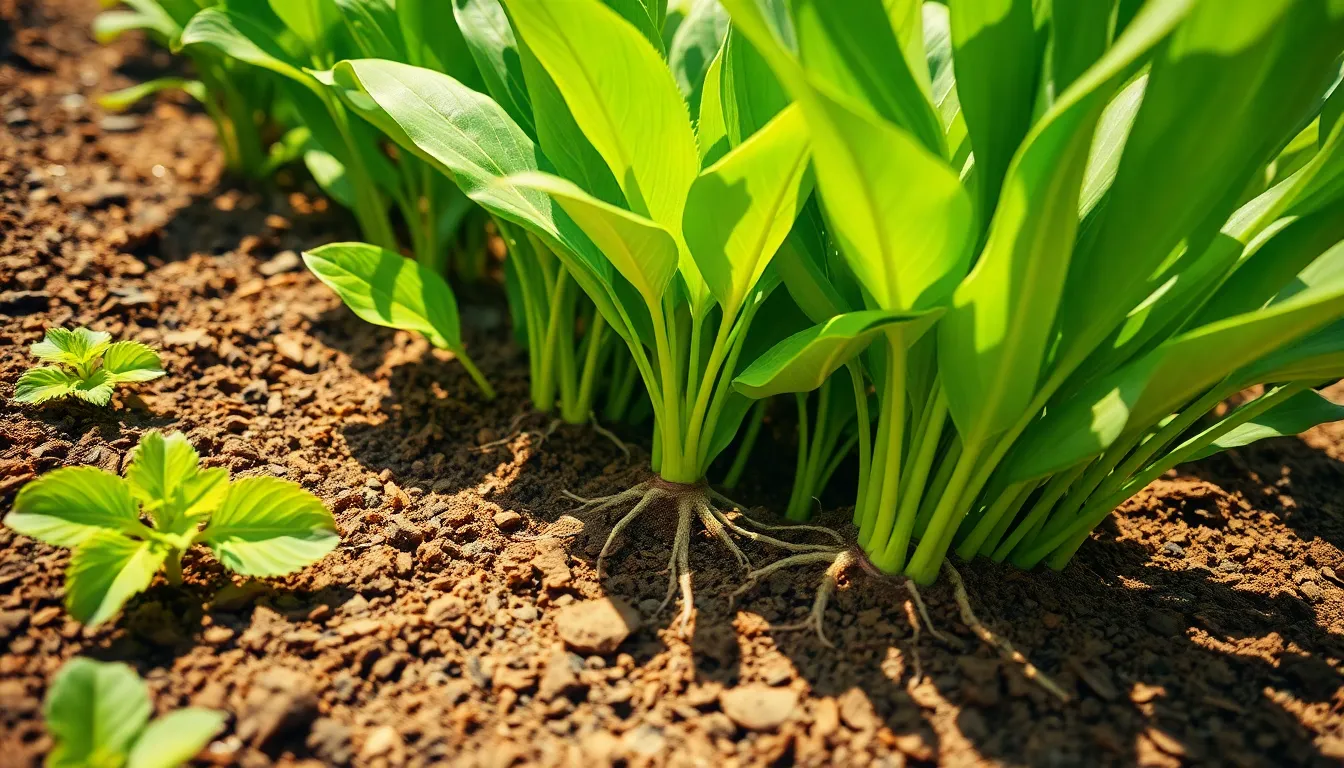
Research demonstrates that hydrogen peroxide applications can significantly enhance plant growth while improving mineral accumulation throughout the growing season.
How Hydrogen Peroxide Enhances Nutrient Uptake
Hydrogen peroxide functions as a powerful signaling molecule that regulates essential plant processes including gene expression and antioxidant enzyme activities. These regulatory effects help plants optimize nutrient metabolism and manage stress more effectively under various growing conditions.
Studies show that H2O2 treatments stimulate bioactive compounds and metabolic pathways directly involved in nutrient absorption. Plants treated with hydrogen peroxide answers demonstrate improved mineral uptake efficiency even during challenging conditions like drought, salinity, and temperature extremes.
We’ve observed that hydrogen peroxide also protects chloroplast structure, which supports photosynthesis and nutrient assimilation processes. This protection ensures that plants can maintain optimal energy production while maximizing their ability to absorb and use available nutrients from the soil.
Stimulating Root Growth with Oxygen-Rich Answers
Root development improves dramatically when hydrogen peroxide decomposes and releases oxygen into the soil environment. This oxygen-rich atmosphere enhances soil aeration and stimulates healthy root growth patterns that increase both nutrient and water absorption capacity.
Enhanced root respiration occurs when H2O2 amendments create better oxygenation around root zones. We find that this improved respiratory environment leads to increased root vitality and supports healthier overall plant development.
Beneficial microbial populations in the soil also respond positively to the oxygen release from hydrogen peroxide breakdown. These microorganisms contribute to nutrient cycling and root health, creating a symbiotic relationship that further enhances nutrient uptake efficiency.
| Root Growth Benefits | Mechanism | Result |
|---|---|---|
| Increased root surface area | Oxygen stimulation | Better nutrient absorption |
| Enhanced root respiration | Improved aeration | Stronger metabolic processes |
| Healthier root development | Oxygen-rich environment | Increased water uptake capacity |
Timing and Frequency for Growth Enhancement Treatments
Weekly applications of hydrogen peroxide answers provide optimal benefits for plant growth and nutrient absorption. Research indicates that concentrations between 16 to 30 mM applied once per week deliver the most effective results without causing oxidative stress.
Seed priming treatments with H2O2 during early growth stages can improve seed quality and enhance post-priming stress tolerance. We recommend starting these treatments during germination and continuing through the early vegetative growth phase for maximum effectiveness.
Continuous stimulation occurs when we maintain this weekly application schedule throughout the growing season. This consistent approach supports ongoing growth enhancement and nutrient uptake improvements while preventing tissue damage from excessive oxidative stress.
Safety Precautions and Proper Dilution Guidelines
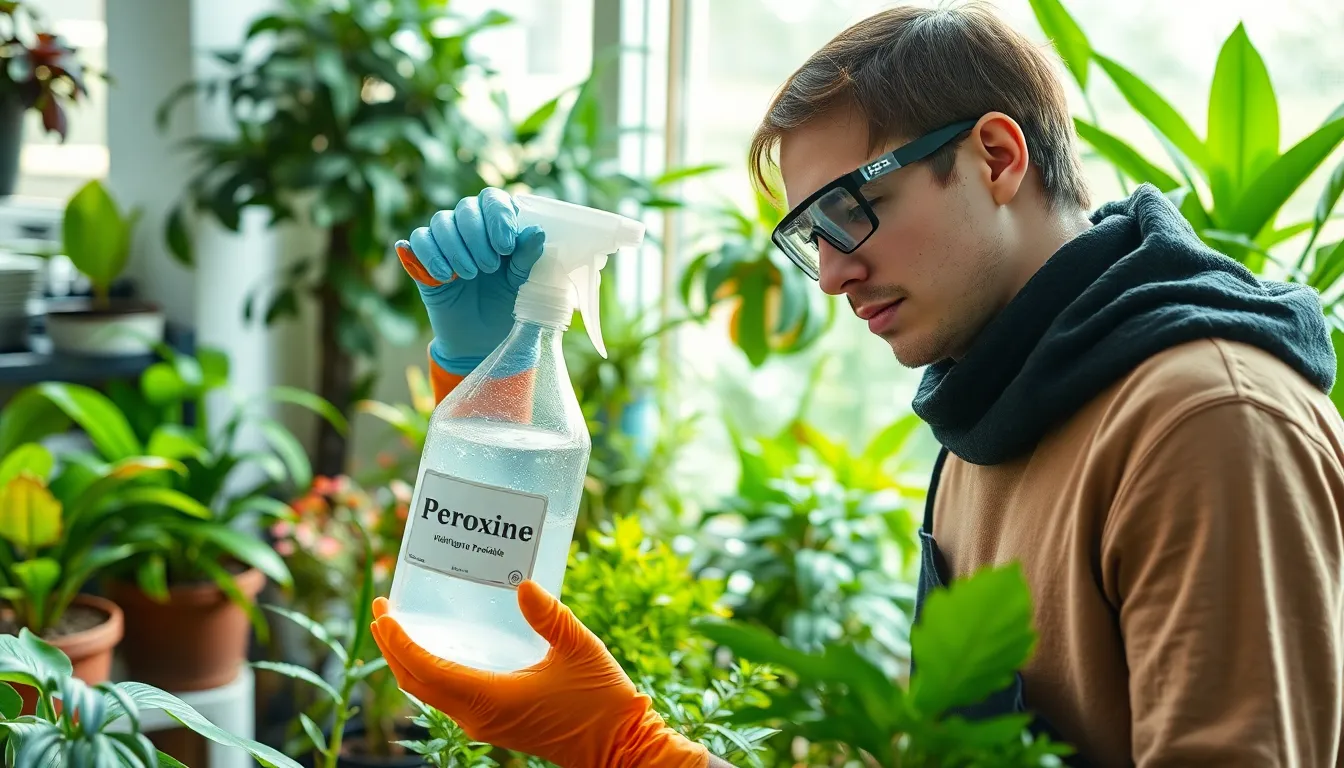
We must prioritize safety and proper dilution to maximize hydrogen peroxide’s benefits while protecting both our plants and ourselves. These precautions ensure effective treatment without causing harm.
Understanding Hydrogen Peroxide Concentrations
Hydrogen peroxide answers come in various concentrations that determine their safety and effectiveness for plant care. Commercial H2O2 typically ranges from 3% to 35% concentration, but we need much lower levels for plant applications.
Diluted answers ranging from 1% to 3% H2O2 are standard for most plant treatments. These concentrations provide antimicrobial benefits while minimizing risk of plant damage.
Higher concentrations above 3% can cause oxidative damage and cell death in plants. Appropriate dilution promotes beneficial signaling effects and controls harmful microorganisms without destroying plant tissues.
We should always check the original concentration before diluting. Store bought hydrogen peroxide is commonly 3%, which requires further dilution for safe plant use.
Essential Safety Measures When Handling Hydrogen Peroxide
Always wear gloves and eye protection when working with hydrogen peroxide to prevent skin and eye irritation. Concentrated H2O2 is corrosive and can cause burns.
Ventilation is crucial when using hydrogen peroxide indoors or in enclosed spaces. We must work in well-ventilated areas to avoid inhaling vapors that can irritate respiratory systems.
Proper storage maintains hydrogen peroxide stability and prevents dangerous decomposition. Keep H2O2 away from direct sunlight and heat sources in a cool, dark location.
Never mix hydrogen peroxide with other chemicals unless specifically recommended by experts. Mixing can create dangerous reactions or reduce effectiveness.
Fresh preparation is essential since H2O2 breaks down over time. We should prepare new answers before each use rather than storing diluted mixtures.
Common Mistakes to Avoid When Using Hydrogen Peroxide for Plants
Using undiluted or excessively concentrated hydrogen peroxide ranks as the most common error that causes oxidative damage to plant tissues. This mistake damages chloroplasts and leads to cell death.
Overapplication frequency disrupts beneficial soil microbiota that plants need for healthy growth. We must balance pathogen control with protecting helpful microorganisms.
Ignoring protective gear creates unnecessary health risks during application. Safety equipment protects us from chemical burns and respiratory irritation.
Plant species sensitivity varies significantly, and failing to research exact needs reduces treatment effectiveness. Some plants tolerate hydrogen peroxide better than others.
Skipping patch tests before full application can result in widespread plant damage. We should always test diluted answers on single leaves before treating entire plants.
Using old or degraded hydrogen peroxide answers wastes time and money while providing minimal benefits. Fresh answers ensure maximum effectiveness for plant treatments.
Conclusion
We’ve explored how hydrogen peroxide can revolutionize your gardening approach through its multifaceted benefits. From treating root rot and preventing fungal diseases to boosting seed germination and improving soil aeration this simple compound offers remarkable versatility for plant care.
The key to success lies in proper application and safety measures. We can’t stress enough the importance of using correct dilution ratios and following safety protocols to protect both ourselves and our plants. Remember that moderation is crucial – too much can harm rather than help.
By incorporating hydrogen peroxide into our regular gardening routine we’re giving our plants the oxygen boost they need while creating an environment where harmful pathogens struggle to survive. This natural approach supports healthier root systems stronger growth and better overall plant resilience.
Start small with patch testing and gradually build your confidence with this powerful gardening tool. Your plants will thank you with improved health and vitality.
Frequently Asked Questions
What is hydrogen peroxide and how does it help plants?
Hydrogen peroxide (H2O2) is a chemical compound that releases extra oxygen when it breaks down, providing numerous benefits for plant health. It enhances root respiration, improves nutrient absorption, prevents diseases, and combats harmful pathogens. This scientifically-supported solution helps gardeners tackle common challenges like root rot and fungal infections while promoting overall plant growth.
How do I treat root rot with hydrogen peroxide?
Create a diluted hydrogen peroxide solution and apply it to affected roots after removing the plant from soil. Clean away rotted roots, disinfect your tools, and repot in fresh soil. Early detection is crucial for successful treatment. Always follow proper dilution ratios and provide appropriate post-treatment care to ensure plant recovery.
What concentration of hydrogen peroxide should I use for plants?
For plant applications, use diluted solutions between 1% to 3% concentration. A common recommendation is mixing four tablespoons of 3% hydrogen peroxide in one pint of water for foliar applications. Commercial concentrations range from 3% to 35%, but higher concentrations can cause oxidative damage and should be avoided for direct plant use.
Can hydrogen peroxide prevent fungal diseases in plants?
Yes, hydrogen peroxide effectively prevents fungal diseases by creating an inhospitable environment for pathogens. Its antimicrobial properties combat common plant diseases and help eliminate harmful microorganisms. Apply diluted solutions as preventive treatments, but ensure proper ratios and application timing to maximize effectiveness while protecting beneficial soil microorganisms.
How does hydrogen peroxide improve seed germination?
Hydrogen peroxide sterilizes seeds by eliminating harmful pathogens that can cause damping-off disease, creating optimal conditions for germination. Treat seeds with a 3% hydrogen peroxide solution before planting to improve germination rates and seedling health. This process enhances seed quality and stress tolerance throughout the growing season.
Is hydrogen peroxide safe to use on plant leaves?
When properly diluted, hydrogen peroxide is safe for foliar applications. Mix four tablespoons of 3% hydrogen peroxide in one pint of water for leaf cleaning and pest management. Always test the solution on a single leaf first and wear protective gear. Avoid undiluted applications as they can damage plant tissue.
How often should I apply hydrogen peroxide to my plants?
Apply hydrogen peroxide weekly for optimal growth benefits, maintaining concentrations between 16 to 30 mM. Monitor your plants’ response and adjust frequency as needed. Avoid overapplication, which can harm beneficial microorganisms and cause oxidative stress. Regular but moderate use provides the best results for plant health and growth enhancement.
What safety precautions should I take when using hydrogen peroxide?
Always wear gloves and eye protection when handling hydrogen peroxide. Ensure proper ventilation and store the solution correctly to maintain stability. Never use undiluted hydrogen peroxide on plants, and always perform patch testing before broader application. Use fresh solutions for maximum effectiveness and follow proper dilution guidelines to minimize risks.

